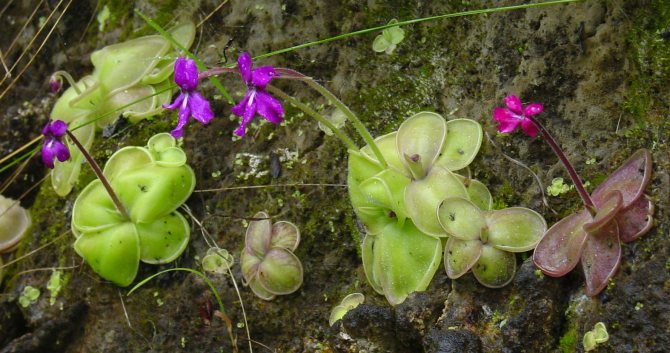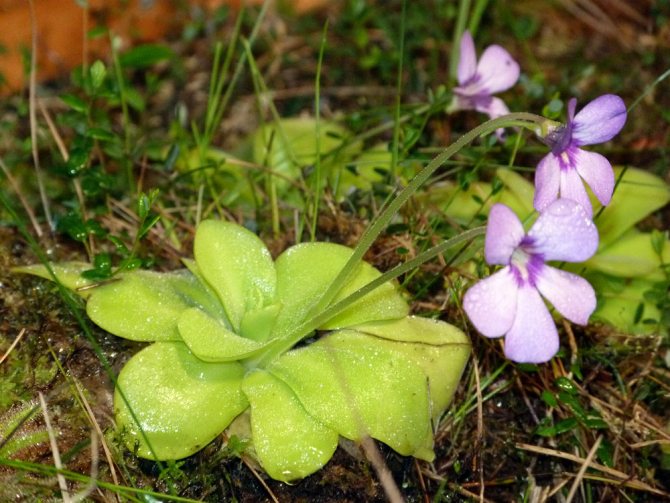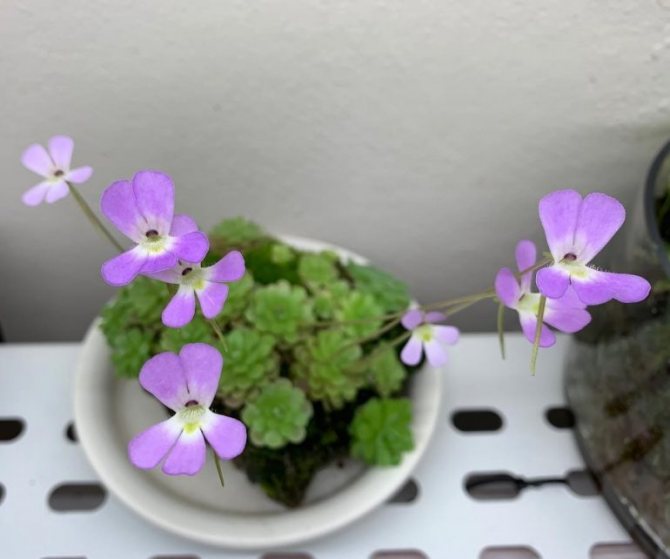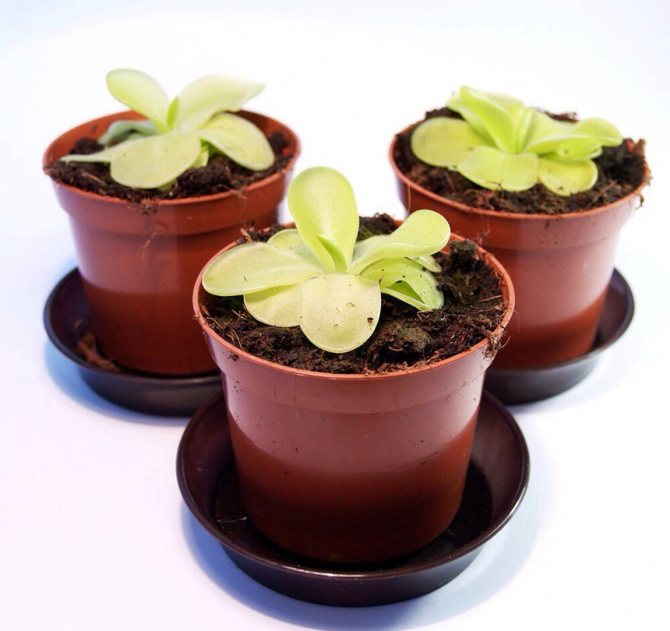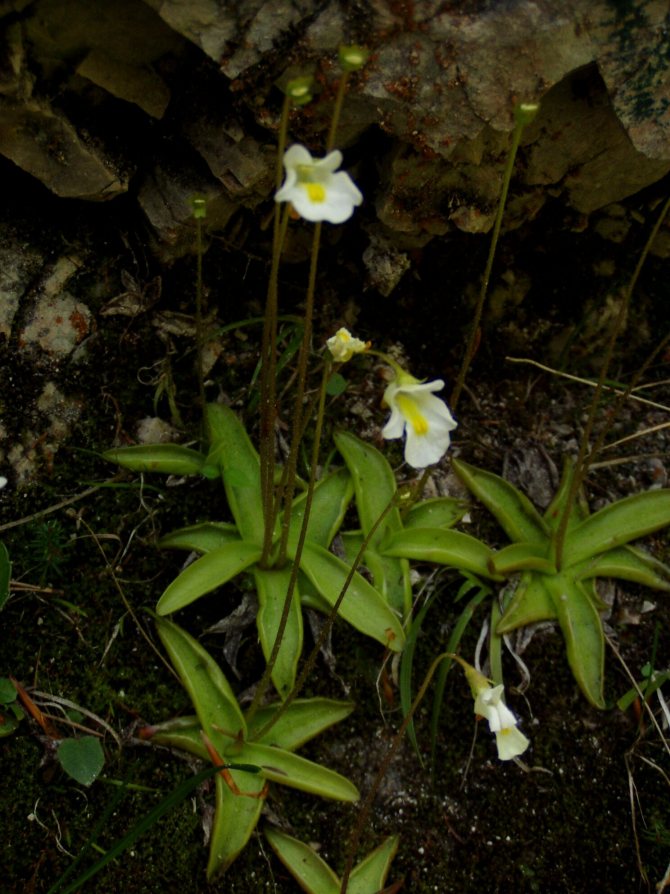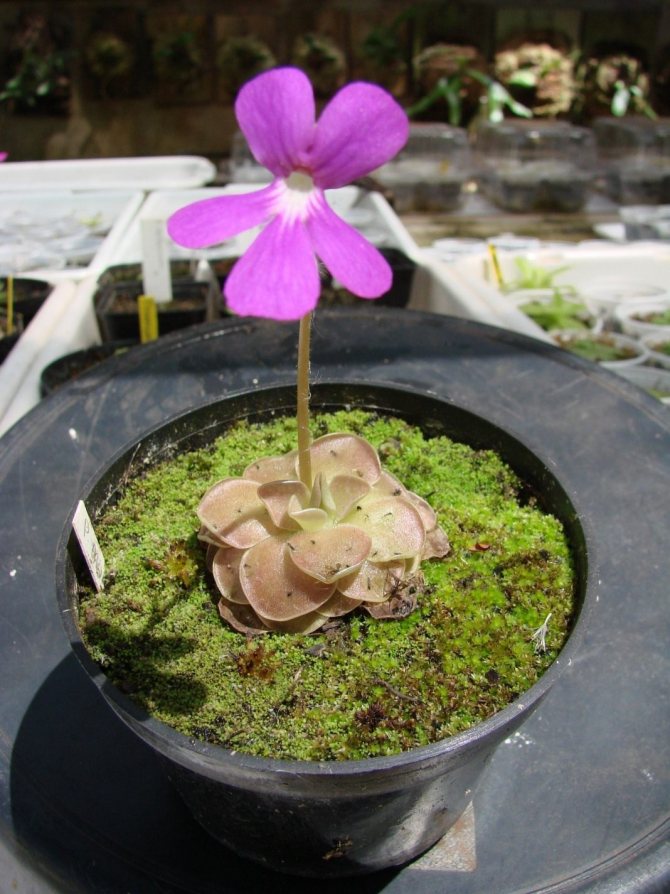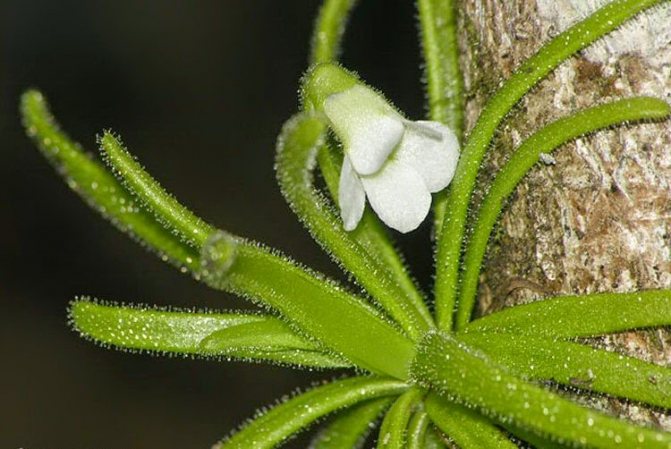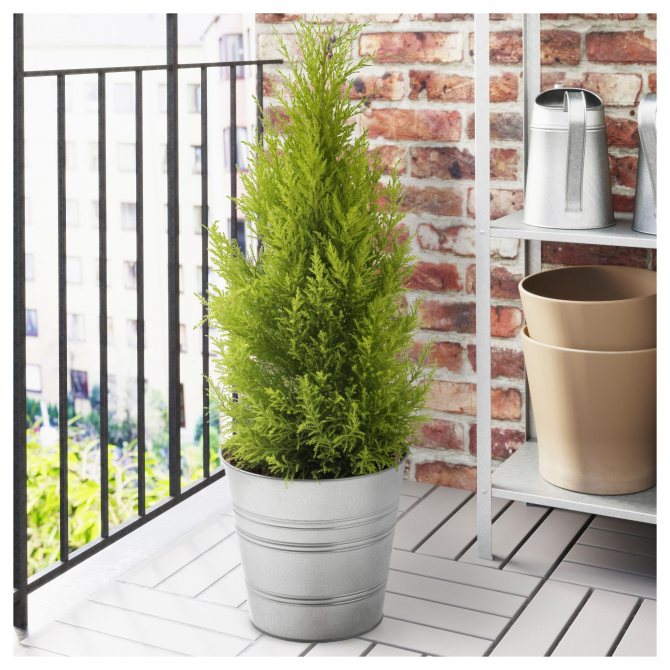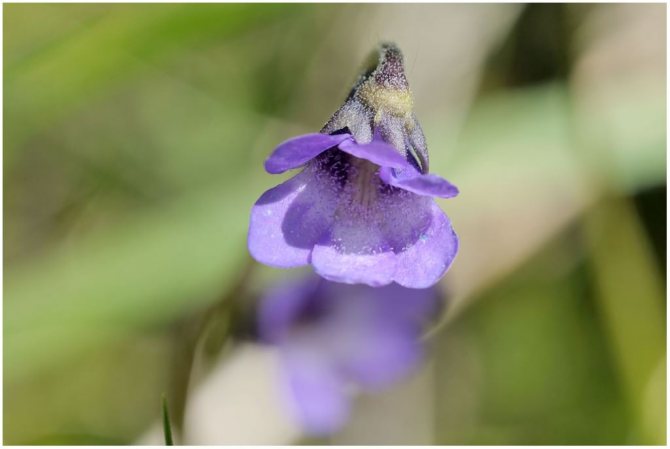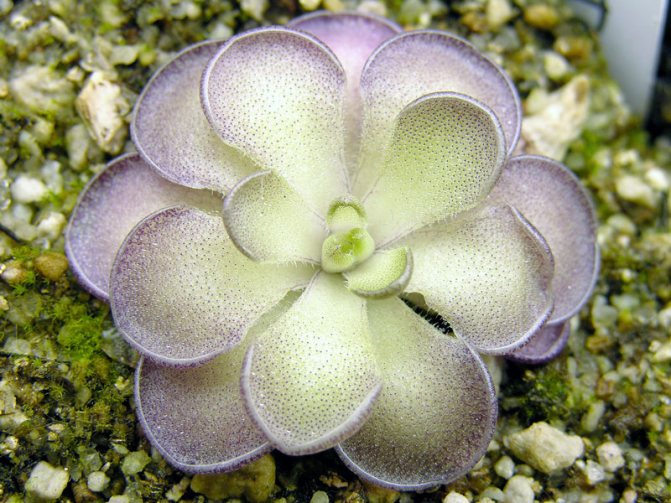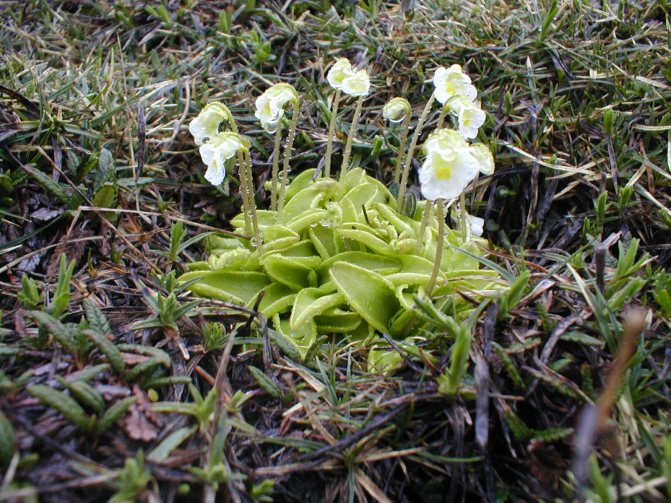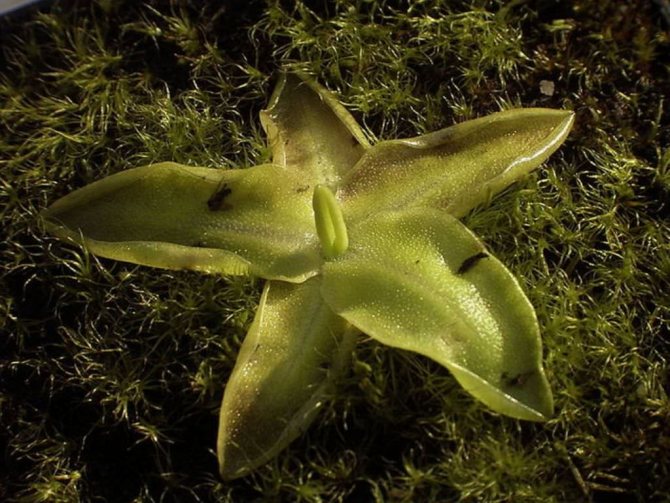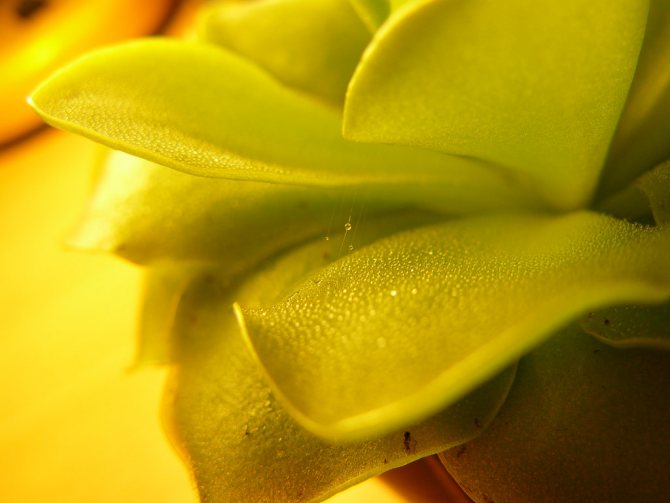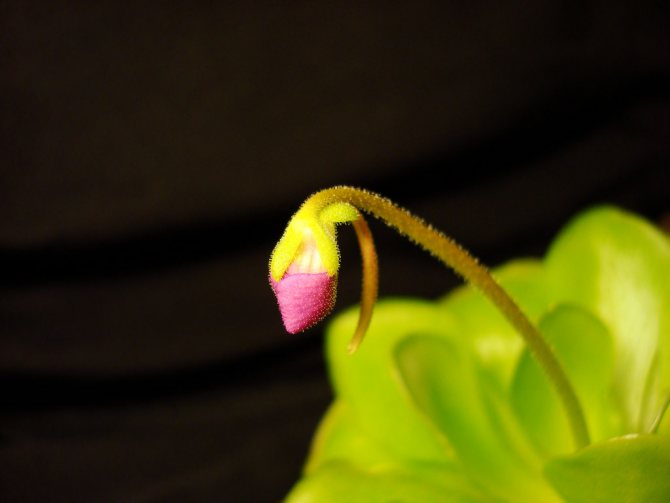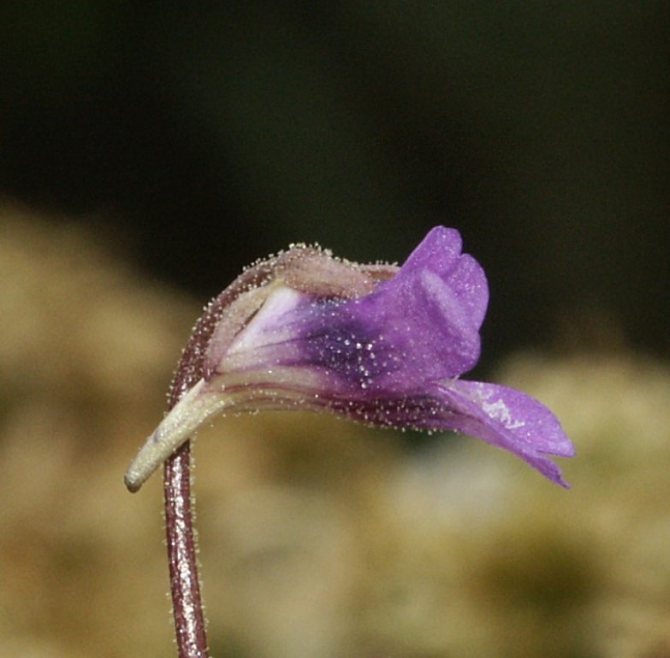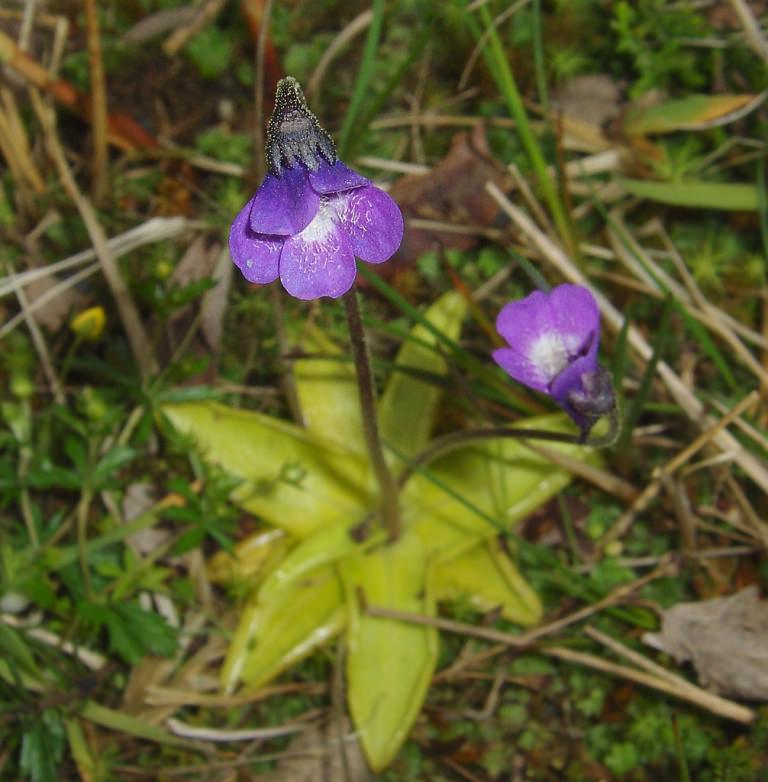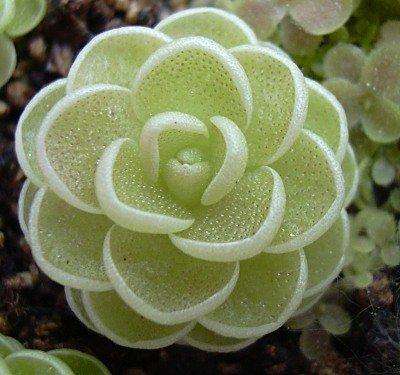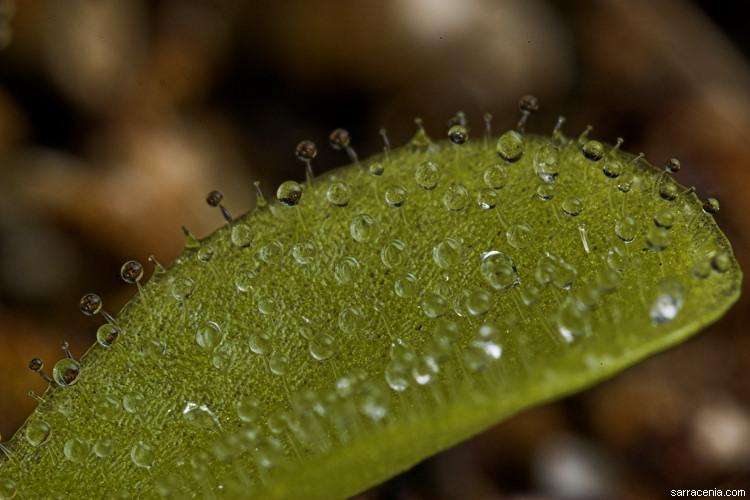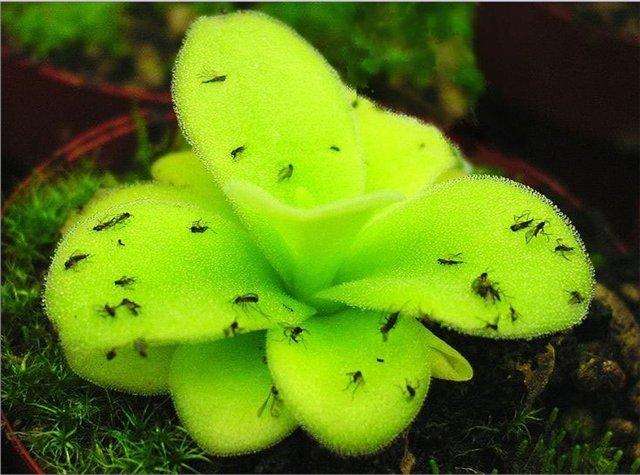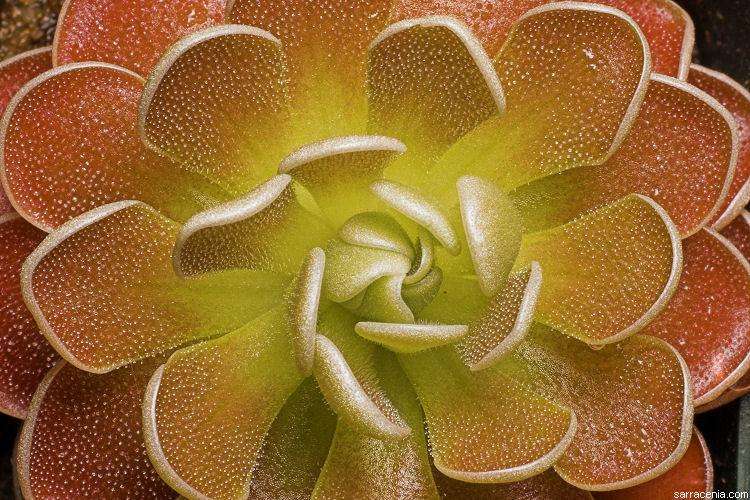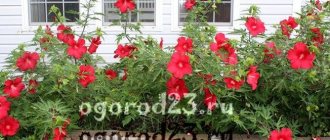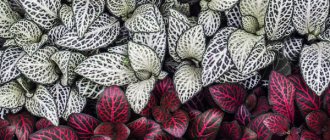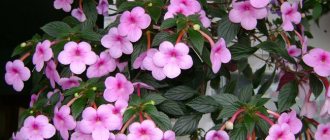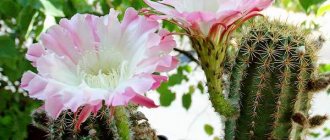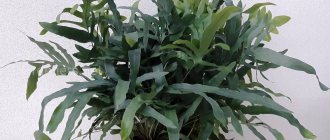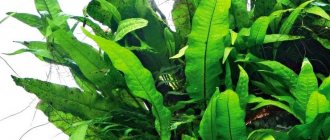Zhiryanka (lat. Pinguícula) is an insectivorous plant from the genus of perennials, occasionally there are also annuals. It belongs to the Lentibulariaceae family. Prefers to grow in water or damp places. A lover of peat bogs, the banks of streams and small rivers, thickets of moss, floodplains of rivers and lakes. The homeland of this carnivorous plant is South America, outside the tropics of the Northern Hemisphere. Twelve species of the predatory plant Zhiryanka can be found in Europe, and six to seven species live in Russia. Of these, the most common is Common Chiryanka (Pinguicula vulgaris).
The plant is capable of flowering. Blooming birchwort is quite decorative. She is very sensitive to any changes. Difficult to tolerate changes in climatic conditions, environmental pollution. This is what contributes to the disappearance of the fatty woman as a species. The growing areas are protected by the state, and the plant itself is listed in the Red Book.
Zhiryanka: care, illness, photo, reproduction
After the formation of small plants, after about a few weeks they are planted.
Bloom
Blooms mainly in spring. Flowers 2-3 cm in size are most often purple in color, but there are pink, blue, white, yellow
Transplant and care features
Young plants are transplanted annually, adults every 2 years in March. Remove the plant from the pot, gently removing the old soil. The root system of the plant is rather weak, but in a new pot there should be enough space for normal flowering and development; in a cramped container, the fatty plant does not grow well. A recess is made in the new soil, where the roots of the plant are placed, then the substrate is leveled around it. After transplanting, it is desirable to provide the plant with increased humidity by placing it under polyethylene. The plant is predatory, insectivorous. Its leaves have numerous glands, to the surface of which small insects adhere, which are digested by the plant. It is not recommended to rotate the plant relative to the light source. The easiest species for indoor cultivation - Moran Zhiryanka Pinguicula moranensis var. grandiflora
and alpine
Pinguicula alpina
... The life cycle of the Moranian Chiryanka includes 2 seasons: wet and dry. In summer, the plant forms carnivorous leaves, in winter, succulent non-carnivorous leaves develop
Difficulties
The plant is resistant to most pests and copes well with them. Problems often arise when the growing regime is violated. In particular, in the bright sun, burns and drying of the leaves are possible. Leaves dry and wrinkle with occasional watering or insufficient air humidity. The lack of flowering can be attributed to insufficient lighting. It happens that plants rot in winter, so it is better to keep them in winter at low temperatures and moderate watering. If in winter the leaves of the plant droop and then fell off, then they provide it with a dormant period, placing it in cool conditions with sufficient lighting
Beneficial features
The extract from the leaves is used in the treatment of coughs and colds, and in veterinary medicine - as a laxative
Photo by Kurt Stueber (https://caliban.mpiz-koeln.mpg.de/mavica/high/5500/05317.html)
If you have already grown a plant and you like it and you recommend it to other growers, you can
Comments:
Growing fat from seeds
The fatty plant at home can multiply by seeds, but this process is not simple enough and not always effective. Seeds are sown in a light, moisture-permeable substrate, without burying or sprinkling. The container with crops is covered with foil or glass to create the desired microclimate inside.
When the air temperature in the greenhouse is about + 22- + 24 ° C, bright diffused lighting and high humidity, seedlings usually appear within a few weeks. The main task at this stage is to preserve them, preventing decay.
To do this, the greenhouse should be regularly ventilated, the plants should be watered sparingly and no sudden temperature changes should be allowed. After another 2-3 weeks, the grown seedlings can be cut into separate pots.
Common Zhiryanka
Common Zhiryanka - Pinguicula vulgaris L. 1753 Family Pemphigus - Lentibulariaceae
Category and status... 3 "Rare" - 3, RD. A relict species of the Pleistocene period with a disjunctive range.
Threat category of the global population on the IUCN Red List
Not included in the IUCN Red List.
Category according to the criteria of the IUCN Red List
Regional populations are classified as Near Threatened, NT; V.V. Akatov.
Brief morphological characteristics
Herbaceous short rhizome polycarpic. Height - 5–20 cm. Leaves are oblong-elliptical, obtuse, light green on the upper side, glandular-sticky, 2–4 cm long, collected in a dense basal rosette. The flower arrow is single or in the number of two or three; at a young age, it is completely covered with small glandular hairs.
The flowers are drooping, zygomorphic, bisexual. The calyx is glandular-pubescent, its lobes are ovoid, bluntly pointed. Corolla two-lipped, with a spur at the base, dark purple, up to 20 mm long. Stamens 2. Fruit - unilocular polyspermous bivalve capsule. 2n = 64.
Spread
Common area: Europe: North, Middle; Mediterranean (eastern); Southeast Asia; Caucasus; North America . Russia: Arctic; European part; Siberia; Far East ; North Caucasus: KK; KCR (the headwaters of the M. Khatipara River, the headwaters of the Ba-Duk River, Northern Klukhor, Nazlykol.
Krasnodar region: Western Caucasus: Belo-Labinsky district (upper reaches of the Urushten River, on Lugansk Lane, single individuals were recorded on the Bolshoi Tkhach, Chertovy Vorota, Bolshoy Bambak, Yatyrgvarta, Mastakan ridge, Acheshbok mountain (7.VIII.1929, A Leskov), the headwaters of the Roshkoa River (19.VII.1930, A. Leskov)).
Features of biology, ecology and phytocenology
Blooms in July - August. Gigrofit. The plant is carnivorous. Microtherm.
Aldrovanda vesiculosa
The plant consists mainly of free-floating stems that reach 6-11 cm in length. Trap leaves, 2-3 mm in size, grow in 5-9 curls in the center of the stem. The traps attach to the petioles, which contain air that allows the plant to swim. It is a fast growing plant and can grow up to 4-9 mm per day and in some cases produce a new curl every day. While the plant grows at one end, the other end gradually dies.
The trap of the plant consists of two lobes that slam shut like a trap. The holes of the trap are directed outward and are covered with fine hairs that allow the trap to close around any victim that gets close enough. The trap closes in tens of milliseconds, which is one example. the fastest movement in the animal kingdom
.
Zhiryanka is a modest indoor predator
It grows in swampy meadows, swampy places, places where spring waters come out and snow melts in the subalpine and alpine zones.
Number and trends
Rare in the entire range. It is rare in the region, in communities it has a low population density. No monitoring studies of the size have been carried out.
Limiting factors
The main habitats are located in the border districts of the KGPBZ within the zone of interests of the ski industry, distant pasture farming. Populations of the species can be destroyed in the event of climate change, as well as the detachment of parts of the territory from the reserve in order to develop ski resorts, graze livestock, and build new highways
.
Security measures
Protected in KGBPZ. Included in the Red Book of RA. Protected in the Teberda Nature Reserve. It is necessary to control the state of populations, study their dynamics in connection with climatic fluctuations, strict regulation of tourist activities in the KGPBZ and along its borders, the invariability of the nature conservation status of the territory.
Information sources. 1. Steinberg, 1958; 2. Vorobieva, Onipchenko, 2001; 3. Semagina, 1999; 4. CSR; 5. Akatov; 1989; 6. Altukhov, 1967; 7. LE; 8. Tsvelev, 2000. Compiled by V. V. Akatov; fig. S. A. Litvinskaya.
AOF | 01.11.2015 15:32:48
Abstract on the topic:
Californian Darlingtonia (Darlingtonia Californica)
Darlingtonia leaves are bulbous and form a cavity with an opening under the balloon-like structure and two sharp leaves that hang down like fangs.
Unlike many carnivorous plants, it does not use trapping leaves to trap, but uses a crab claw type trap. Once the insect is inside, they are confused by the specks of light that pass through the plant. They land in thousands of thick, fine hairs that grow inward. Insects can follow the hairs deeper into the digestive organs, but cannot go back.
Introduction
Moraine fatty
(lat.
Pinguícula moranénsis
) - perennial insectivorous plant; species of the genus Zhiryanka (
Pinguicula
) of the family Pemphigus (
Lentibulariaceae
). Natural range - Mexico and Guatemala. The view was discovered by Alexander von Humboldt and Aimé Bonplan during their expedition to South America (1799-1804). First described by Humboldt and Bonpland, together with Karl Kunt in the book
Nova Genera et Species Plantarum
published in 1817. The species is very variable; over time, several of its varieties were isolated into independent species, differing in area and morphological features.
The scientific name of the genus Zhiryanka is Pinguicula
- comes from lat.
"Pinguis"
which means "fat". It was given because of the "oily" leaves of the plant. Specific epithet -
moranensis
- comes from the name of the area
Mina de Morán
(now the state of Hidalgo in Mexico) where the view was opened.
Transplant and substrate
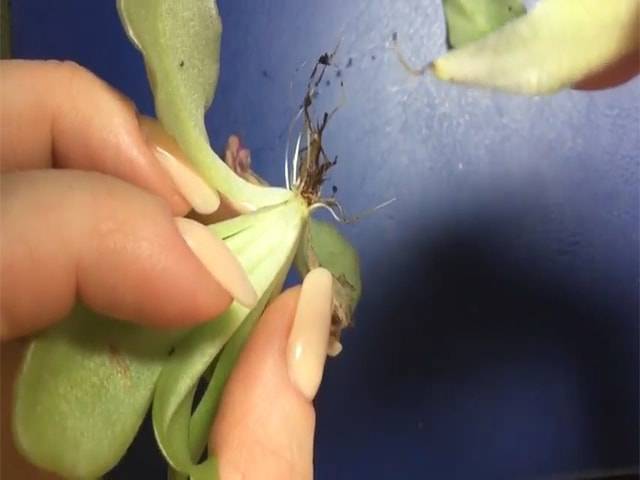
Acidic soil is suitable for the fatty predator. The basis of the substrate is peat. It is diluted with perlite, vermiculite or coarse sand. Today they sell ready-made soil for various plant crops. You can also buy a ready-made acidic substrate for ordinary Velcro, designed specifically for carnivorous plants.
The transplant process is simple. It is enough to carefully pull the roots out of the soil, remove the stuck earth. Make a depression in a new pot with fresh substrate. Place the roots in it, sprinkle with soil and, pressing down, fix it a little. Drizzle and leave in a bright room.
It is best to replant the insectivore in late winter or early spring, so that the roots have time to take root in the new substrate, and the plant can bloom by summer.
Classification
1.1. Varieties
After much debate, scientists came to the conclusion that the Moranian Zhiryanka species has two varieties, differing in the shape of the leaves of the winter rosette:
1.2. Taxonomic position
View Zhiryanka morana
belongs to the genus Zhiryanka (
Pinguicula
) of the family Pemphigus (
Lentibulariaceae
) of the order Luminous (
Lamiales
).
| childbirth Pemphigus and Genlisei | section Crassifolia , Homophyllum , Longitubus , Nana , Orchidioides and Pinguicula | ||||||||||||||||||
| 2 varieties | |||||||||||||||||||
| family Pemphigus | subgenus Pinguicula | view Zhiryanka morana ( Pinguicula moranensis ) | |||||||||||||||||
| order Luciferous | genus Zhiryanka ( Pinguicula ) | section Orcheosanthus | |||||||||||||||||
| 21 more families, including Yasnotkovye, Norichnikovye and Olive | subgenus Isoloba and Temnoceras | 11 more species | |||||||||||||||||
Pemphigus (Utricularia)
These are the only carnivorous plants that use bubble trap
... Most species have very small traps in which they can catch very small prey, such as protozoa. Traps range in size from 0.2 mm to 1.2 cm, and larger traps will trap larger prey such as water fleas or tadpoles.
The bubbles are under negative pressure relative to their surroundings. The opening of the trap opens, sucks in the insect and surrounding water, closes the valve, and all this happens in thousandths of a second.
Botanical description
The leaf blades of the summer rosette of the Moranian beetle are smooth, succulent, their color varies from yellow-green to burgundy, tear-shaped or rounded, 5.5-13 cm long, with a petiole 1-3.5 cm long. They are densely covered with glands that secrete a sticky liquid that is used to catch insects, as well as digestive glands. Winter rosette 2-3 (5) cm in diameter, without glands, consists of 60-100 leaves 10-30 mm long and 3-8 mm wide, covered with hairs.
During the flowering period, one plant produces from 1 to 7 single flowers. Pedicels are long, 10-25 cm long, erect, green or green-brown, covered with glandular hairs. The flowers themselves are 30-50 mm long, consist of 5 petals, the color of which varies greatly - from pink to lilac or white.
The fruit is a capsule containing many seeds 1 mm long.
Carnivorous plant genlisea (Genlisea)
Genlisea is a small herb with yellow flowers that use a crab pincer trap
... It is easy to fall into such traps, but it is impossible to get out of them because of the small hairs that grow towards the entrance or, as in this case, forward in a spiral.
These plants have two different types of leaves: photosynthetic leaves above the ground and special underground leaves that lure, trap and digest small organisms
such as protozoa. The underground leaves also serve as roots, such as water absorption and attachment, since the plant itself does not have them. These underground leaves form hollow tubes that are spiral-shaped. Small microbes enter these tubes through the flow of water, but cannot escape from them. When they get to the exit, they will already be digested.
Large-flowered fatwort
Cultivation
The following varieties of Moranian Zhyryanka are known:
| Variety name | Origin | Description |
| Pinguicula ‘George Sargent’ Hort. Slack | P. moranensis × gypsicola | Lilac flowers, large winter rosettes. |
| Pinguicula ‘Hameln’ Hort. Studnicka | P. gypsicola × moranensis | The leaves are wide. |
| Pinguicula ‘John Rizzi’ Hort. D'Amato | P. moranensis × ? | Large flowers, oval leaves. |
| Pinguicula ‘Mitla’ Hort. Studnicka | P. gypsicola × moranensis | The leaves are wide. |
| Pinguicula 'Pirouette' Hort. J. Brittnacher, B. Meyers-Rice & L. Song | P. agnata × (moranensis × ehlersiae) | Leaves are pink. |
| Pinguicula ‘Sethos’ Hort. Slack | P. ehlersiae × moranensis | The flowers are large, with a white center. |
| Pinguicula ‘Weser’ Hort. Slack | P. moranensis × ehlersiae | The flowers are large, with a white line in the middle of the lower petal, the veins are dark. |
Chiryanka (Pinguicula)
The leaves are juicy and usually bright green or pink in color. There are two special types of cells on the upper side of the leaves. One is known as the pedicle gland and is made up of secretory cells at the apex of a single stem cell. These cells produce a slimy secretion that forms visible droplets on the leaf surface and acts like Velcro
... Other cells are called sessile glands, and they sit on the surface of the leaf, producing enzymes like amylase, protease, and esterase that aid in the digestive process. While many types of birchworms are carnivorous all year round, many types form a dense winter rosette that is not carnivorous. When summer comes, it blooms and has new carnivorous leaves.


The color and size of the petals of the Moranian beetle are very variable.
Some types of carnivorous plants that are found among lovers of extraordinary home greenery fit very well into the interior and are helpers in the fight against annoying insects.
Nepenthes
Nepentes, a tropical carnivorous plant, is another type of carnivorous plant with a trap that uses trapping leaves in the shape of a water lily. There are about 130 species of these plants, which are widespread in China, Malaysia, Indonesia, the Philippines, Madagascar, Seychelles, Australia, India, Borneo and Sumatra. This plant also received the nickname "monkey cup
“Since the researchers often observed how the monkeys drank rainwater from them.
Most of the Nepentes species are tall vines, about 10-15 meters, with a shallow root system. Leaves are often visible from the stem with a tendril that protrudes from the tip of the leaf and is often used for climbing. At the end of the tendril, the water lily forms a small vessel, which then expands to form a bowl.
The trap contains liquid secreted by the plant, which can have a watery or sticky texture, and in which insects, which the plant eats, drown. The bottom of the bowl contains glands that absorb and distribute nutrients. Most of the plants are small and they only catch insects, but large species such as Nepenthes Rafflesiana
and
Nepenthes Rajah
,
can catch small mammals such as rats
.
Sarracenia
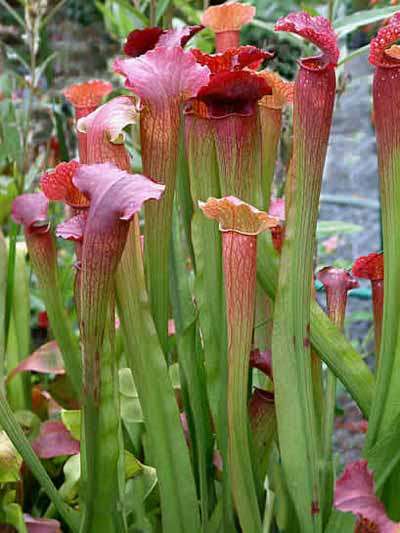

This carnivorous plant looks like an elongated bowl, the top of which ends with a kind of canopy roof. The roof does not allow rainwater to penetrate, so that it, in turn, does not interfere with the digestion of insects that have fallen to the bottom of the water lily. Colorful sarracenias attract with their fragrant nectar, which is collected at the entrance to the jug. And on the very neck there are villi that make it easy to get inside, but do not give the opportunity to get out. Thus, the poor insect enters the environment for digestion and by no means will it be able to get out.
There can be about 35-40 such bowls-jugs on one plant. Each pitcher can serve as a great hideout for moths and larvae. The spiders, by exposing their webs near the entrance to the bowl and waiting for the hungry insect to peck, have also found a benefit in this vibrant plant.
How is insect catching?
Velcro has many glands on its leaves. Some secrete a viscous, sweet, insect-luring secret. Others form enzymes to digest them.
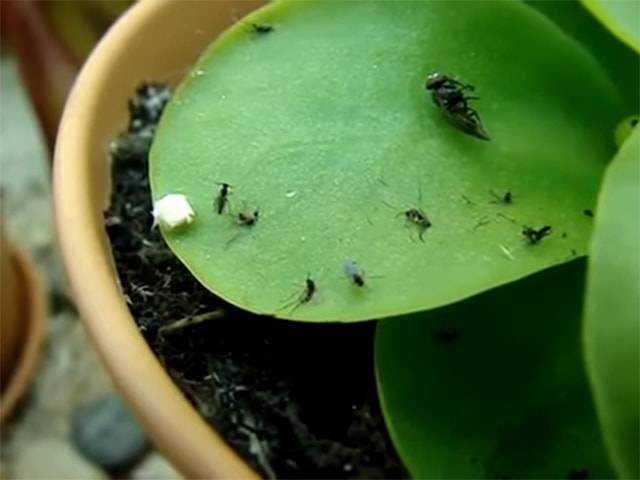

When an insect hits a leaf, it sticks to it. In attempts to free itself, it actively moves, the leaf reacts: it begins to curl, and the glands secrete even more sticky substance.
Velcro does not completely twist the leaf, as, for example, another prominent member of the pemphigus family, the sundew. It rolls up at the edges - the middle remains open.
When the insect is killed, the glands begin to produce an enzyme that dissolves the protein. After digestion, which lasts about a day, the leaf straightens out and awaits a new victim.
Zhiryanka
The fatty plant is so named because its leaves are covered with sweet mucus, outwardly resembling fat secretion. This serves to catch insects. And other mucus, which is contained in the predatory plant, is necessary to dissolve the insect. Zhiryanka leaves are collected in one root rosette. They have pleasant shades of flowers: purple, blue, light cream and pink. It can grow up to 15cm in height.
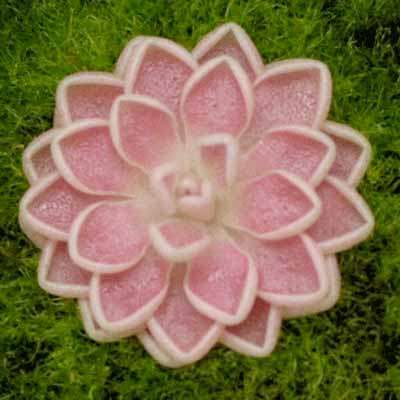

An insect that decides to feast on fragrant flower nectar is firmly glued to the leaf of the plant. After that, the leaf begins to curl up and further digest the victim.
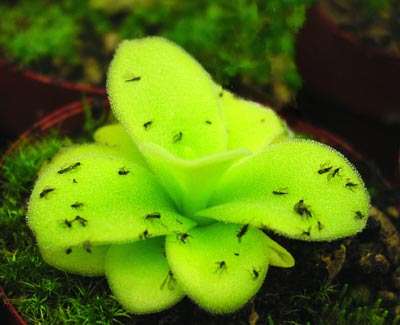

Reproduction of zhiryanka by leaf cuttings
Leaves are usually propagated in autumn. The cuttings are carefully separated from the mother plant, the cut sites are treated with crushed charcoal and the resulting material is sent to take root in peat or other light substrate. After the appearance of strong roots, the cuttings are seated in individual pots.
For the first time, you can create greenhouses made of polyethylene or glass for young plants in order to maintain the necessary air humidity. When the cuttings start growing, the greenhouses are removed.
Pemphigus
An insectivorous plant that is the largest of the carnivorous plants. This plant has about 230 species and is distributed almost everywhere, bypassing only Antarctica, where there is no warm climate. Blossom with bright yellow flowers.
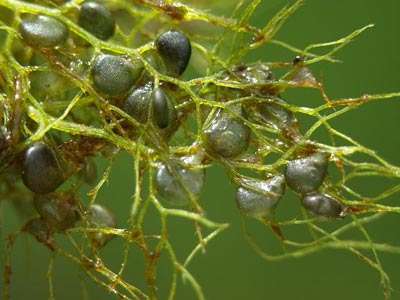

When catching prey, it uses bubbles, after which it was nicknamed the Pemphigus. It lives in water bodies, swamps, ditches and lakes. Just like Aldrovanda, it does not have a root system, therefore it lies freely on the surface of the water, waiting for food.
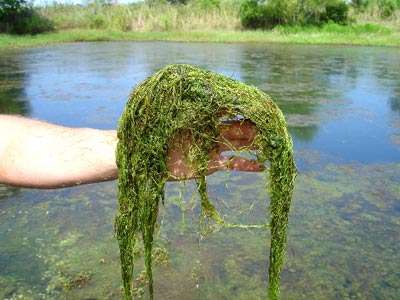

Small bubbles of a predator plant have a valve that cleverly opens into the bubble, thus launching an insect or small living creatures in the water. At the slightest touch, the valve opens, dragging a nearby creature with water. Alas, it is already impossible to get out of the trap.
Reproduction
The small predator reproduces like the rest: by seeds, division or cuttings. Seed propagation is a less popular method. For the first shoots to appear, you need to expect from several weeks to several months. Such a flower will be weak and less adaptable to climatic changes than its parent.


Cutting is the most acceptable and common way to propagate a plant, even an insectivorous one. The best time for transplanting and reproduction is the end of winter, before the onset of spring vegetation and further flowering.
The stalk or seeds are placed in the desired substrate and conditions are created for successful germination. The soil should be moderately moist and the humidity high. Some growers cover the pot with seeds or a shank with a cap to create the desired temperature regime.
Zhiryanka
Common Zhiryanka: description and growing conditions
Maybe you remember, swimming in the river in the summer, you noticed how, coming out of the water, green algae clung to your hair, hard and unpleasant to the touch. I remember, as a child, we dumped these ooze with friends. Such a thorn without roots.
- Similar plants => Dewdrop, Venus flytrap, Aldrovanda, Nepentes, Rosolist
# 1 Predatory Zhiryanka
| Fluffy Moderator
Active forum member |
Zhiryanka (PinguIcula) is a genus of perennial insectivorous plants of the Pemphigus family (Lentibulariaceae). Popular names: blue zhiryanka, oily grass. The name of the plant comes from the Latin "pinguis" - "fat", "fat", because of the fleshy, oily shiny succulent leaves; it indicates that the surface of the leaves is covered with thousands of tiny glands that secrete a slimy secretion.
Zhiryanka fully shares the food addictions of another predatory flower - the sundew. The food of zhiryanka is simpler than that of sundews. The leaves of the plant form a root rosette. The upper side of the leaf is covered with numerous glands: some of them secrete sugary mucus, which is a trap for small insects; other glands generate enzymes that aid in the digestion of food.
For small insects, the sticking effect is sufficient. If the prey is large, the fat can roll its leaf a little, and the mucus dissolves the proteins of the victim's body. It is estimated that 1 cm of a leaf contains about 25,000 glands. Each piece of leaf is capable of functioning only once. When most of the iron is used, the leaf dies off. A new leaf appears every five days. In one season, the plant is able to catch several hundred insects.
Flowers are solitary, on long peduncles. Possible color: purple, blue, pink, rarely white. They grow in swampy meadows and swamps. |
Home care
She reacts to the slightest changes in her environment, but at the same time she is not too demanding and is able to adapt to conditions. Not all species are so unpretentious.For example, the southern ones require more heat and light, the northern ones feel comfortable in the shade.
Lighting
Sticky and wet leaves do not tolerate direct sunlight. She needs 2-4 hours of solar "mode". It is best to place it in the western or eastern part of the room in partial shade.
To make the Velcro feel comfortable, you need to adhere to one regime all year round. There is no need to rearrange the pot depending on the season or day.
Comfortable temperature
The optimal temperature regime is considered to be 25-35 ° C in summer, and 15-20 ° C in winter. She easily adapts to room temperatures, so she is considered one of the most unpretentious insectivorous species.
For abundant flowering, it will be beneficial if there are at least slight fluctuations between night and day temperatures. In the marshy areas where this flower grows, it is much cooler at night than during the day. By recreating natural climatic conditions, you can achieve beautiful, long-lasting flowering.
It is advisable to ventilate the premises where the Velcro predator is located daily. Fresh air is the key to good growth and abundant flowering.
Watering and air humidity
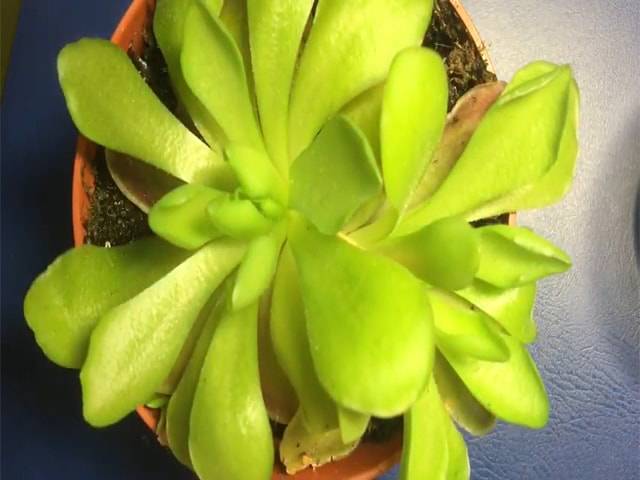

Good growth requires high air humidity (50-60%) and constantly moist soil. In the summertime, when the soil dries out quickly due to high temperatures, it is necessary to water every two days. Less often in winter: once a week is enough. Zhiryanka is not particularly sensitive to the quality and composition of water. You can water it with the same water that you are used to watering other plants. Whether it's rainwater, distilled water or settled tap water.
You do not need to water the substrate, but into the pallet. Otherwise, the predator may die or get sick. In addition, leaves and flowers cannot be sprayed. This will disrupt the nutritional process and the work of the glands.
Do you need artificial feeding?
Many who have an insectivorous in their care are perplexed: how to feed a flower and how to understand whether it is "hungry" or not?
Some owners of these modest predators are sure that in winter, when there are especially few insects, you need to help her to saturate. For example, put live midges, mosquitoes on the leaves or lure them with fruits left nearby.
Experts say that she will feed herself on her own, even in winter. This predatory flower, even without fruits rotting nearby, can lure midges to itself.
You do not need to fertilize the soil. It must be remembered that this is a predator that feeds on insects, and not on trace elements coming through the roots from the soil.
Violet-flowered fatweed (Pinguicula ionantha)
Violet-flowered fatweed is a rare species of flowering plants of the family Pemphigus.
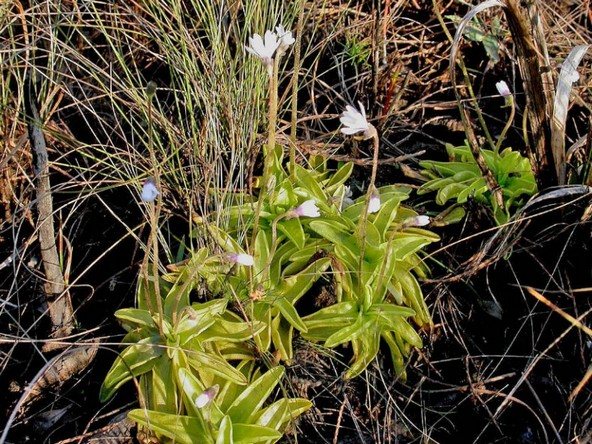

Description: This perennial herbaceous insectivorous plant forms a rosette of bright green leaves with fleshy edges. The leaves, each up to 8 centimeters long, are covered with sticky hairs. The flower is pale purple. The corolla has greenish spurs at the back. The center of the flower is covered with yellow or red hairs. Corolla lobes have white hairs.
Flowering period: February-April.
Habitat: The grass is widespread in the United States. Grows in swamps, deep bogs, damp depressions and puddles. In many countries, the violet-flowered jellyfish is ranked among endangered species. The plant is threatened by forest fires. In addition, prolonged drought can reduce the number of plants.
Vegetative propagation
Wintering buds (leaves) are used as material for vegetative propagation. The new rosette can be divided into several parts and planted as independent plants, but do this before spring growth begins. Some fatty women on the edges of the leaf plates form babies (like the Kalanchoe viviparous).
Root delenki and "kids" in a sandy-peat mixture or clean sand.You will also need to create a humid environment (cover the top with a glass jar or a cut plastic bottle), heat and diffused light.
The choice of dishes for planting
When choosing utensils for planting fat, you need to evaluate the size of the root system and the previous pot in which the plant was located. The flower does not require a large vessel, but it will not be comfortable in a cramped one.
Florists recommend for planting use "closed" pots. The plant is placed in a mini aquarium. One layer of pebbles or other small stones is laid out on the bottom. To maintain high humidity, a small amount of water is poured, which slightly covers the substrate. A pallet is placed on the pebbles and a pot of grease is placed on it.
Such conditions of detention are most favorable for the flower. It should be understood that even if you can achieve high humidity in the room, then furniture or walls will suffer from this (fungus will settle), so it is simply necessary to use an aquarium.
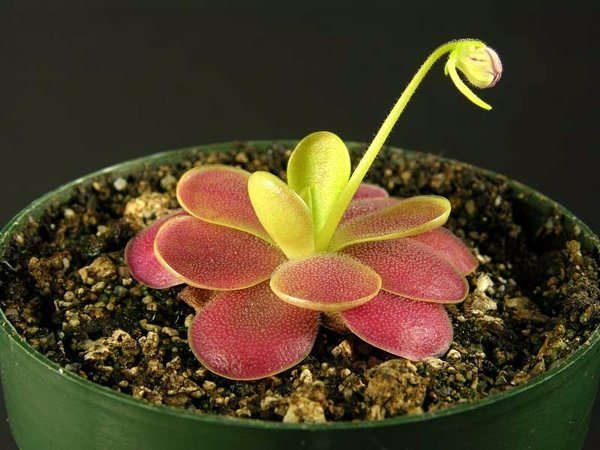

Spread
The Zhiryanka plant has a fairly extensive growing area. For this reason, there are species that are resistant and not resistant to frost.
The plant is found in Japan and Europe, in the Andes and North America, on the Asian continent.
Zhiryanka prefers peat bogs and simply wetlands, that is, those places where there are a lot of insects. However, when drained (artificial or natural), the plant dies off very quickly, therefore, almost all the habitats of the zhiryanka are taken under protection.
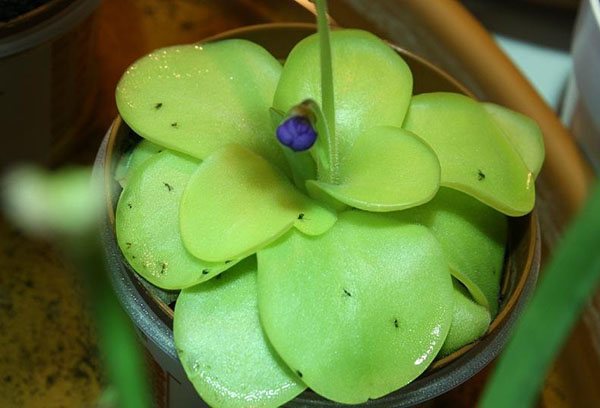

On the territory of Russia there are about 6-7 species. The most common species is the common zhiryanka, it can be seen in northern latitudes. And in the Urals, an alpine species grows. In Mexico, only two species are found: plaster and rounded.
How to feed the plant?
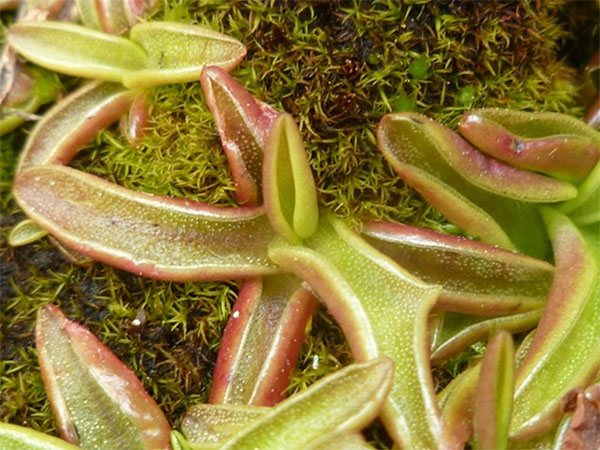

Zhiryanka is an insectivorous plant, therefore, feeding should be appropriate. It should be fed exclusively by insects. To do this, just put a small piece of sweet fruit (you can melon) next to the flower. In a short period of time, small fruit flies will flock to it. However, many experts urge not to feed the plant on purpose. Under suitable conditions, the flower will independently find its "food" by catching a midge.
Gypsum fat (Pinguicula gypsicola)
Description: the rhizome is simple, short, but there are many adventitious filiform roots. Numerous basal leaves have a ciliate structure and an oblong-wedge-shaped or obtuse shape (1.5-8 cm long, 2-3.5 mm wide). Pedicel erect; the flower has a characteristic purple hue. The corolla is divided into an upper and a lower lip; purple petals. The corolla diameter is 2 to 2.5 cm.
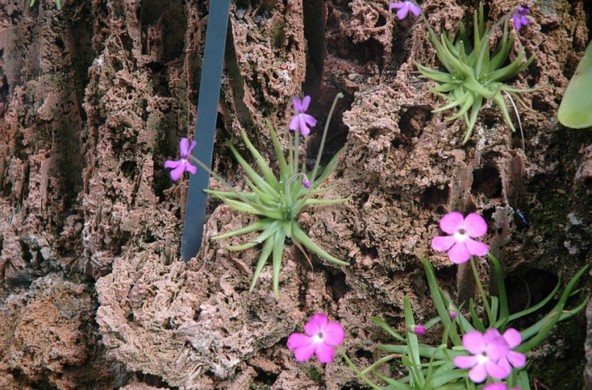

Distribution and habitat: the plant is native to Mexico, also found in Brazil. This type of gristle was first found and studied in 1910 near a gypsum quarry located in San Luis (1300 m above sea level). In 1991 it got its name and began to be cultivated in Europe. The habitat of plaster of Paris requires a more detailed description. The typical habitat for this plant is rocky hills: the grass grows either in crystalline crevices or in thin layers of eroded soil.
Prefers the more shaded side of the hill, facing north or northwest, as there is less evaporation of water from the soil and the temperature is lower. However, sometimes the plant can be found in the shady places of small canyons. During the dry season (December to June), the plant receives moisture only from morning fogs. More regular rain is observed between August and November, but the hill itself also retains moisture, which provides the plant with additional feeding.
Flowering: from June to November (depending on soil moisture); flowering may start later.
Moran Butter (Pinguicula moranensis)
Moran fatweed is a perennial insectivorous plant.


Description: In summer, the plant forms a basal rosette of leaves up to 10 centimeters in length, which are covered with mucous glands. Like other species, the Moranian beetle feeds on insects. The nutrients extracted from the flesh of small arthropods are used to supplement the existing nutrients found in the soil. In winter, Moranian beetle loses its rosette and takes the form of a small predatory plant. The flower has a pink or purple hue, is located on a vertical stem up to 25 cm long. The plant blooms twice a year.
Distribution and Habitat: This species was first found in Mexico in 1799. To this day, the plant grows in Mexico, as well as in Guatemala. Moran oil is widely cultivated all over the world.
Alpine bead (Pinguicula alpina L.)
Alpine bead is a solitary plant with a relatively long life span.
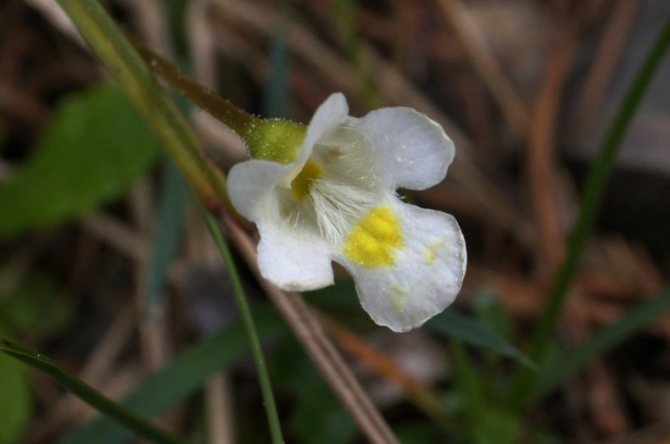

Description: in contrast to the common birchwort, the peduncle of this plant is slightly shorter. Pivotal rhizome, brown; adventitious roots are pale yellow with one rosette of leaves at the base. Plant height - 5-15 cm. Leaves are alternate, located at the base, 4-5 in one rosette, up to 4 cm in diameter, have sticky glands on the surface. The color of the leaves ranges from yellowish green and dark red to pink. A single flower of alpine white birchwort with yellow pollen.
Distribution and habitat: the plant is very thermophilic. Occurs on southern slopes and rocks, in the middle arctic zone. Alpine bead is a European and Siberian type of alpine beetle, widespread in the northern and highlands.
Flowering: Usually one new bud opens in one season.
Filamentous ghiryanka (Pinguicula filifolia)
Giryanka filamentous is a perennial plant, another insectivorous subspecies of the genus Zhiryanka.
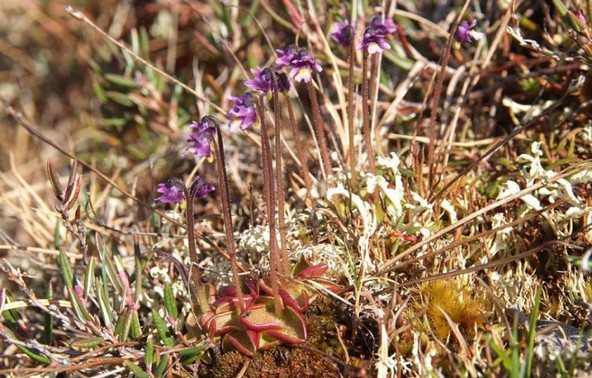

Distribution: filamentous birchwort covers a wider ecological zone than other species. It is found mainly in the western part of Cuba and in some neighboring regions. Girlyanka filamentous was first discovered in 1866.
Habitat and ecology: filamentous beetle grows near coastlines and in swamps. Grass thrives in swamps with high temperatures and high humidity of air and soil. However, the dry season, which lasts from November to April, this plant withstands with dignity.
Description: the length of the leaves of the filamentous ghee is 4-6 mm, the width is 1-1.5 mm. Like most other types of pork fat, this tropical plant uses its sticky secretions on its leaves to trap small insects, pollen and other plant debris to supplement its own diet. The socket has a diameter of 8-10 mm. One rosette usually has 4-6 blades. Each flower has 5 petals. The petals range in color from white to yellow, from blue to purple.
Flowering: The flowering period is mainly in the summer season (July, August), but the plant can bloom all year round.
Threats: due to the constant stay in the swamp, filamentous boggy often faces the threat of rotting. When the fatty plant reaches mature growth, the leaf blades take an upright position. This upright position helps her to avoid rotting and fungal diseases.
Venus flytrap (Dionaea Muscipula)
Its leaf plate is divided into two areas: flat, long, heart-shaped petioles capable of photosynthesis and a pair of terminal lobes hanging from the main vein of the leaf, which form a trap. The inner surface of these lobes contains red pigment, and the edges secrete mucus.
The leaf lobes move abruptly, snapping shut when its sensory hairs are stimulated. The plant is so developed that it can distinguish a living stimulus from a nonliving one
... Its leaves collapse in 0.1 second. They are bordered by cilia, rigid, like thorns, which hold the prey.As soon as the victim is caught, the inner surface of the leaves is gradually stimulated, and the edges of the lobes grow and merge, closing the trap and creating a closed stomach, where the prey is digested.
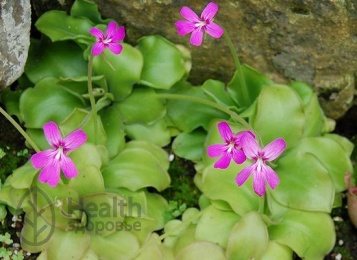

Syn .: oily herb, blue zhiryanka.
Zhiryanka is a unique genus of carnivorous perennials. It currently has over 70 species. Zhiryanka is common in Europe, Asia, Japan, the Andes and North America. The plant is not used in official medicine, but one of the species, common pork fat, has found its application in traditional Asian medicine. The plant is prized in Scandinavian cooking and as an ornamental houseplant among amateur flower growers. Some types of zhiryanka are included in the Red Book.
Table of contents
In floriculture
Zhiryanka is a genus of predatory indoor plants most popular among flower growers. Florists-decorators call representatives of this genus insectivorous shy, capable of surprising with the tenderness of flowers resembling violets, and a spectacular non-standard color of bright light green leaves.
However, this plant is often in demand among avid botanists not so much for decorativeness, but for some exotic "zest" that can bring unexpected accents and notes to home collections. Home gardeners note that these plants cannot be noted with special catchiness, they make only a deceptively simple impression, captivating with their cuteness, ruthlessness and modesty.
In medicine
Representatives of the genus Zhiryanka are not included in the State Pharmacopoeia of the Russian Federation, however, Zhiryanka vulgaris is used in folk medicine, decoctions and juices are prepared from the leaves, stems and flowers of this species.
Contraindications and side effects
Plants from the genus Zhiryanka are not medicinal. Contraindications to their use were not identified, since the plants have not been studied and are not used in official medicine. That is why any use of zhiryanka both internally and externally is not recommended.
In cooking
The peoples of Northern Scandinavia use zhiryanka leaves to prepare a local specialty called tetmielk. To do this, Scandinavians add zhiryanka leaves to fresh milk. After a while of infusion on the leaves of the plant, the milk turns into a stretching homogeneous mass. Scandinavians love this dish very much.
Classification
Zhiryanka (Latin Pinguicula) is a genus of perennial insectivorous plants from the Pemphigus family (Latin Lentibulariaceae). The genus includes over 70 species, among which the most famous is the Common Fat (lat.Pinguicula vulgaris).
Botanical description
Representatives of the genus Zhiryanka are widespread in Europe, Asia, Japan, the Andes and North America. Several species of this genus were later found in South America, Mexico and the Caribbean. As a rule, Zhiryanka settles in wetlands and peat bogs. The insectivorous genus Zhiryanka is the only genus of the Puzyrchatkovy family, whose representatives have not only trap leaves, but also real roots. These roots help representatives of this genus to survive in adverse conditions and circumstances, without feeding on insects.
The leaves are fleshy, juicy and have an oily sheen. As a rule, they are painted in a light green color and have an oval shape. They are collected in a neat and rather beautiful rosette, under which the so-called "false stomach" is located. Zhiryanka leaves shine from a sticky mucous secretion that is secreted by a plant for catching insects. From this, they outwardly seem too bold, for which the genus got its name.
Zhiryanka flowers are small and solitary, up to 2-3 cm in diameter, but have long peduncles. Painted in purple, pink, blue, and sometimes dazzling white. Botanists have noticed that purple or bluish flowers are rare. They are quite attractive and resemble violets.The fruit of the zhiryanka is a box. The seeds of all representatives of this genus are rather small, the endosperm is poorly developed. Zhiryanka reproduce with the help of seeds and cuttings.
Since the bushwort is a genus of insectivorous plants, the hunting mechanism in all its species is the same. The upper side of the leaf plate is completely covered with glands of two types, the first glands exude sweet and sticky mucus, which first intoxicates the insect, after which it is a trap for it, and the second perform the function of digestive enzymes.
The leaves of the zhiryanka, unlike the sundew, curl rather slowly, therefore, when digesting some small insects, they simply do not have time to wrap themselves up to the end. This allows everyone who does not hesitate to observe the unusual sight in all its glory, the insect is digested in front of our eyes in the leaves of this cute and cute plant.
If a large insect gets stuck in the trap leaves, the leaves need more time to digest such a victim. Then the mechanism of slow twisting and gradual cleavage of protein compounds is triggered. It is no coincidence that there is an opinion that zhiryanka is a living Velcro tape.
In the development of all representatives of the genus Zhiryanka there are two periods: dry and wet. This means that zhiryanka are capable of producing both summer trapping leaves and winter ones (small and pubescent), which are in fact points of growth or buds. All this leads to the fact that the zhiryanka plant forms two rosettes in one year, a real (summer) one and a so-called succulent (winter) one.
This genus of insectivorous plants includes more than 70 species. And only 5 of them have easily adapted to the culture. All of these species are native to Central America. You should briefly consider them.
Read also: Pork carbonate dishes in the oven
Zhiryanka round-split. It has a flat and almost round rosette, which consists of oval leaves. They are painted in gray-silver colors with blurred purple edges. The diameter of such leaves is no more than 3 cm. They are arranged in a spiral. The leaves of this type of zhiryanka are formed underground. The flowers of the round-dividing bloom are purple, have a large lower petal.
Moran oilseed. This is a species with a rather spectacular summer rosette of burgundy or yellow-green leaves. In length, these leaves reach 13 cm, they are smooth and perfectly round. The pubescent leaves of the winter rosette of the Moranian beetle are small, 3 cm long.This type of beetle blooms twice a year with lilac or white single flowers up to 5 cm in diameter.
Gyryanka is gypsum. In the wild, this fatty plant grows on gypsum rocks, so it is fully adapted to dry conditions of existence. It has a round rosette, long wedge-shaped leaves. The flowers of gypsum zhiryanka appear in June-November and have a purple hue.
Common Zhiryanka. This species differs from its congeners in pear-shaped yellow-green leaves. They are small, up to 4 cm in length. The peduncle of the flowers of the common birch tree reaches a height of 17 cm. The flowers are painted in a raspberry-purple color. The flowering of the common zhiryanka occurs in July. This species is used medicinally in Asian folk medicine.
Alpine Zhiryanka. It has oblong leaves. Their length is up to 13 cm, and their width is up to 1.5 cm. They are assembled into a beautiful (like other species) rosette. The flowers of this species are white, and sometimes light yellow. In contrast to other species, alpine birchworm can carry out photosynthesis. The flowering period for this species is June-July.
Spread
Representatives of the genus Zhiryanka are widespread in Europe, Asia, Japan, the Andes and North America. Several species of this genus were later found in South America, Mexico and the Caribbean. As a rule, Zhiryanka settles in wetlands and peat bogs.
Procurement of raw materials
The medicinal benefits of zhiryanka have not been scientifically proven, however, for medicinal purposes, the herb of zhiryanka ordinary is used among traditional healers.Since the zhiryanka plant is rare, its mass collection and harvesting is not officially carried out.
Chemical composition
Alkaloids, tannins, flavonoids, and phenolcarboxylic cinnamic acid were found in the herb of common pudding.
Pharmacological properties
The medicinal properties of Zhiryanka have not been scientifically proven. However, it is known that due to the alkaloids, flavonoids and tannins found in the common oil, this species is used as a wound healing, laxative, analgesic and tonic. It is believed that the extract of the common pork fat helps to improve the condition of the body in severe forms of asthma. None of this has been scientifically proven.
Application in traditional medicine
Traditional healers from Asian countries prepare a decoction of the herb of the common pork fat for lotions for burns, wounds, rashes, abscesses, tumors. Such a decoction is also used as a wound healing agent. In Asian folk medicine, it is customary to use the juice of the herb zhiryanka ordinary in case of constipation, liver diseases, dysentery, and respiratory diseases. In the countries of Western Europe, the extract of the herb of common pork fat is used by local healers as an antitussive and expectorant agent.
Historical reference
This genus of insectivorous plants owes its name to the special structure of its own leaves. They are quite fleshy, and the sticky trap is very similar to the fat that envelops the leaves. The Latin word pinguis ("fat", "fat") formed the basis of the international scientific name of this genus - Pinguicula.
Zhiryanka is a plant protected by law. The fact is that zhiryanka is an indicator plant that is extremely sensitive to climate change and environmental pollution. But most importantly, the fatty woman with enviable regularity suffers from the detrimental influence of humans on it. That is why some species of this genus (for example, the violet-flowered fatwort) are included in the Red Data Books of many countries of the world.
Literature
1. Plant life. In 6 volumes. Vol. 5. Part 2. Flowering plants / Ed. A. L. Takhtadzhyan. - M .: Education, 1981.
2. Zhiryanka // Great Soviet Encyclopedia: [in 30 volumes] / Ch. ed. A.M. Prokhorov. - 3rd ed. - M .: Soviet encyclopedia, 1969-1978.
3. Zhiryanka // Encyclopedic Dictionary of Brockhaus and Efron: in 86 volumes (82 volumes and 4 additional). - SPb., 1890-1907.
4. Gubanov IA et al. 1196. Pinguicula vulgaris L. - Common Fat // Illustrated guide to plants of Central Russia. In 3 volumes - M .: T-in scientific. ed. KMK, Institute of technologist. issl., 2004. - T. 3. Angiosperms (dicotyledonous: dicotyledonous). - S. 229.
5. Gudrupa I. Introduction of the genus Pinguicula in the Botanical Garden of the University of Latvia // Floriculture: history, theory, practice: Materials of the VII International Scientific Conference. - Minsk: Confido, 2019.
6. Flora of the USSR: in 30 volumes / started at the hands of. and under chap. ed. V.L. Komarova. - M.; L .: Publishing house of the Academy of Sciences of the USSR, 1958 .-- T. 23 / ed. volumes by B.K.Shishkin. - S. 121-122. - 776 p.
Some organisms are able to capture energy from sunlight and use it to make organic compounds. This process, known as photosynthesis, is essential to sustain life as it provides energy for both producers and consumers. Photosynthetic organisms, also known as photoautotrophs, are organisms capable of the process of photosynthesis and include higher plants, some protists (algae and euglena), and bacteria.
In photosynthesis, light energy is converted into chemical energy, which is stored as glucose (sugar). Inorganic compounds (carbon dioxide, water, and sunlight) are used to produce glucose, oxygen, and water. Photosynthetic organisms use carbon to produce organic molecules (carbohydrates, lipids, and proteins) that are needed to build biomass.
Oxygen, produced as a byproduct of photosynthesis, is used by many organisms, including plants and animals, for cellular respiration. Most organisms rely on photosynthesis, directly or indirectly, for nutrients. Heterotrophic organisms, such as animals, most bacteria and fungi, are not capable of photosynthesis or the production of biological compounds from inorganic sources. Thus, they must consume photosynthetic organisms and other autotrophs for nutrients.
Diseases and pests of zhiryanka
One of the undoubted advantages of Zhiryanka is absolute immunity to indoor pests and diseases. Any insect that encroaches on the territory of Zhiryanka will become a victim of this insidious, albeit very cute plant. So you can forget about prevention and control.
Not damaged.
Does not get sick, is not afraid of pests. The danger for zhiryanka is:
- not distilled water;
- top watering;
- excessive lighting;
- turns in relation to the light source.
Vallisneriifolia (Pinguicula vallisneriifolia)
Vallisneria fatweed is another species of insectivorous plants belonging to the pemphigus family.
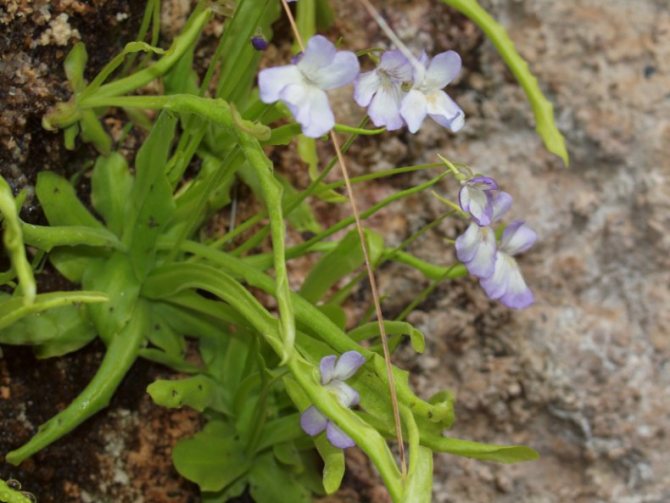

Distribution and habitat: the plant lives in rocky areas and limestone zones at an altitude of 600-1700 meters above sea level. The perennial herb loves wet, but protected areas from direct precipitation. Vallisneria fatweed is widespread in the mountains of Spain.
Description: the flower is pale pink or purple, less often white or pale blue. Corolla petals are 15-22 mm long. Basal leaves are 12.5 cm in diameter and 12 cm high; the color of the outlet is terracotta,
Blossoming Period: Vallisneriella usually blooms in May or early June.
Cultivation: Long-term cultivation will be a difficult task. The necessary growth conditions are: good air humidity, low temperature and an ultraviolet lamp.
Chiryanka (Pinguicula cyclosecta)
Round-cut fatty dish is the simplest type of fatty dish.
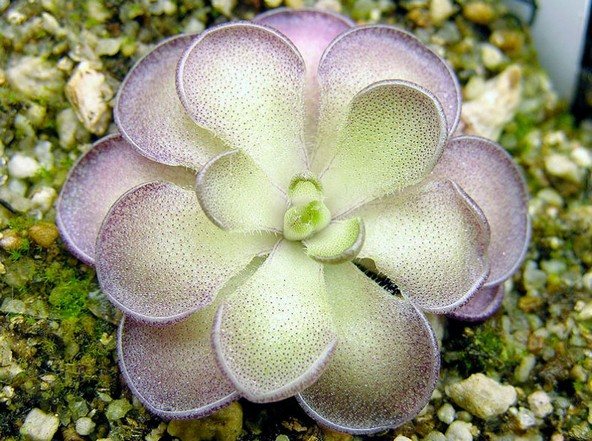

Description: the plant differs from other species in rounded pale green sessile leaves. Numerous leaves are collected in a dense rosette. The diameter of the rosette is 20 cm, the height of the peduncle is 12 cm. The corolla is very fragile, purple in color. The rhizome is short, simple, with many filamentous adventitious roots. This herb needs minerals. Therefore, like many types of pork fat, this plant uses its leaves as a velcro to trap insects (in order to supplement a poor diet).
Distribution: Mexico is the birthplace of the round-cut fat. In the wild, perennial grows in forests: on limestone rocks and tree trunks. Sometimes it grows in areas with a lot of mosses or simply on cracks in the rocks (on the north side of the rocks).
The first photosynthetic organisms
We know very little about the earliest sources and organisms of photosynthesis. There have been numerous suggestions as to where and how this process originated, but there is no direct evidence to support any of the possible origins. There is overwhelming evidence that the first photosynthetic organisms appeared on Earth from about 3.2 to 3.5 billion years ago in the form of stromatolites, layered structures similar to the forms that some modern cyanobacteria form. There is also isotopic evidence of autotrophic carbon fixation around 3.7-3.8 billion years ago, although there is nothing to suggest that these organisms were photosynthetic. All of these statements about early photosynthesis are highly controversial and have caused a lot of controversy in the scientific community.
Read also: What mushrooms are classified as inferior
Although life is believed to have first appeared on Earth about 3.5 billion years ago, it is likely that early organisms did not metabolize oxygen. Instead, they relied on minerals dissolved in hot water around volcanic vents. It is possible that cyanobacteria began to produce oxygen as a byproduct of photosynthesis. As the concentration of oxygen in the atmosphere increased, it began to poison many other forms of early life. This led to the evolution of new organisms that could use oxygen in a process known as respiration.
Substrate for Zhiryanka
When choosing a soil for a predatory plant, it is necessary to take into account the fact that the grease loves high humidity, but not roots (excessive moisture causes them to rot). That is why the substrate for the flower must pass moisture well. The ideal option would be a mixture of peat (50%), coarse river sand (40%) and small pebbles.
If it is not possible to prepare the described mixture, then any store-bought soil that has good drainage properties can be used as a substrate.
Important! It is strictly forbidden to take ordinary garden or garden soil. In such a substrate, the flower can die very quickly.
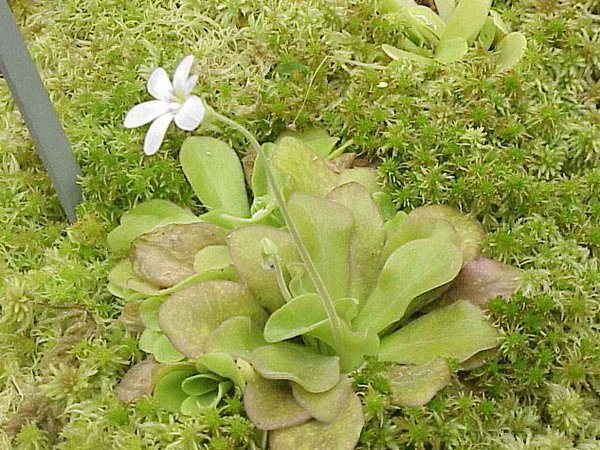

Airing
An important point in the cultivation of a fatty dish is regular airing of a fatty dish. Airing is necessary to remove excess condensation from the leaves. Zhiryanka is not afraid of drafts, therefore, it is necessary to open windows every day to provide the plant with oxygen. The plant reacts normally to temperature changes, however, sharp temperature fluctuations should be avoided, limiting ventilation in the winter.
To obtain constant air, an insectivorous perennial in the summer is rearranged on the balcony or taken out into the garden. Thus, the plant receives a sufficient amount of food and air.
Plant care
Your predator plant requires specific care, so when caring for a flower at home, you need to be prepared for non-standard feeding and timely soil moisture.


Watering zhiryanka
It is often necessary to water zhiryanka only if it is very hot in the house. For watering, use distilled water (in extreme cases, boiled), which is poured into the pan of the flowerpot. After the soil has absorbed the required amount of moisture, remove the remains to avoid root rot.
It is also worth remembering that the water should be at room temperature. Watering with cold water or water from the pipeline is prohibited.
Fertilizing and feeding
Top dressing of zhiryanka is quite specific, since the plant receives nutrients not through the roots, but with the help of the leaves. In this case, the source of useful substances are small insects, which the plant "hunts".
Important! Top dressing must be live. Meat of livestock or other animals is not suitable for feeding.
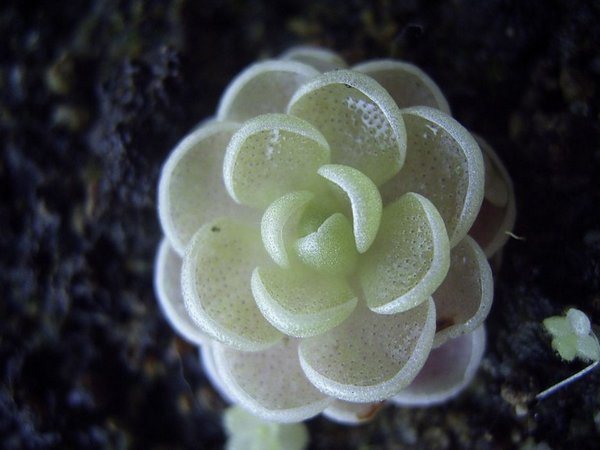

If you have a desire to help the plant get food, then you should put it in the place where flies, midges or mosquitoes most often fly. If you really want to, you can catch a few midges yourself and carefully place them on the leaves of the plant.
As a top dressing, "house" ants, which often live on a shelf with sweets or sugar, are well suited.
At the same time, the entire plant will not die or get sick if you do not feed it.
Thus, zhiryanka does well without expensive fertilizing, and caring for it at home is not difficult or time consuming.
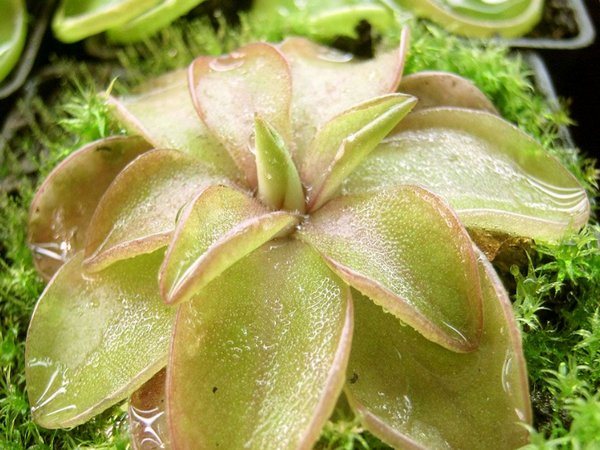

Interesting Facts
Insectivorous fatweed is not included in the list of traditional medicinal plants. However, many folk recipes use perennials as a medicinal product. So, on the basis of the plant, drugs are obtained for the treatment of asthma and diseases of the upper respiratory tract.
Perennial has many constituent minerals that can help cope with cramps and pain.
Zhiryanka is used in Canada to make cheese.In this case, cheese makers put leaves in fresh milk and leave in this state for a while. After that, the finished cheese is eaten. This is due to the fact that zhiryanka secretes enzymes that easily break down animal proteins, which is enough to obtain thickened milk and cheese.
Varieties
The most widespread species is common fatty fish, it grows even in the tundra and mountain ranges of the northern hemisphere. Alpine species grows in the same latitudes, it also prefers the mountain-forest belt, but where there is a lot of moisture.
Gypsum and round-cut fatty plant grows in Mexico. The Moran variety is found in Guatemala and Mexico.
The flat-leaved species is quite rare and grows only along the northern part of the Gulf of Mexico, from Louisiana to Florida.
Vallisneria fattyanka grows only in the south of Spain. The leaves of the plant are more like lawn grass. Since 1997, it has been on the verge of complete extinction.
The filamentous species is widespread in Cuba. And the violet-flowered species is represented only on the Florida peninsula. A characteristic feature of the plant is that the flowers are white, and the inside is purple.
Crystal zhiryanka is found in Cyprus and Turkey.
In many regions, these insectivorous flowers have completely disappeared due to the development of peat deposits and due to the drainage of swamps.

